Entry # 9 - Namibia - August 1 - 8, 2023
Goodbye to Namibia,
Originally, what drew us to Namibia were the striking, varied, and extreme landscapes. However, travelling to Africa meant we were definitely going to go on safari and see animals that, previously, we’d only seen captive in zoos. We were lucky enough to have several opportunities to do so, in a variety of wonderful settings.
While we were on our Nomad tour we spent several days in the enormous Etosha National Park. Considering that the park’s territory covers more than 22,000 square kilometres you’d assume finding animals might be like searching for a needle in a haystack.
Luckily, being here in the dry, winter months means that water is scarce and the few remaining watering holes draw out the crowds. In fact, about 5 minutes after entering Etosha, we were treated to an amazing scene. A flock of giant vultures was devouring the remains of a recent kill with a hopeful jackal looking for a bite, ostriches were scattered about amid groups of ambling zebras, and statuesque antelopes, called oryx, stood at the ready for any reason to leap to safety. Oh… and giraffes and elephants too!!
Over the next few days, we had some incredible sightings as we drove (for hours and hours) through the maze of dusty paths and visited the thirst-quenching watering holes throughout the park.
Each night we would have accommodations in a different region of the park, and have the chance to sit right by a watering hole, just waiting for the nightly visitors to arrive and grab a sip.
These evenings were a photographer’s dream.
Waiting on bated breath, silently surveying the land, the small crowd of hopeful onlookers would quietly gasp and point at silhouettes materializing in the distance or at animals cautiously revealing themselves from their hiding spots in the bush. Smiling to ourselves, we’d watch the various creatures take a refreshing drink and mingle with their fellow watering hole-goers. It was a deeply satisfying feeling to snap the perfect picture, of creatures great and small, who were gracing us with their presence in the glow of the setting sun.
Lee has a special talent for capturing these magical moments. Most photos I take are backlit, blurry, and off-centre. We are so fortunate that Lee has been documenting our trip with photos as stunning as these.
One day we woke up at dawn and froze our butts off in the open-air safari truck, in an attempt to spot the elusive big cats that typically only bust a move in these early morning hours. Unfortunately, we had no luck. Oh well. Time for new goals. We wanted to get up close to some elephants. Um… it seems they were taking the day off.
When there seemed to be a victor in the tussle, the final show of dominance was… well…
Let’s just say, Jessie covered her eyes.
After saying goodbye to Etosha, we headed for the capital city of Windhoek, where we had a very informative walking tour. Every story of colonialism is that of heartbreaking violence and injustice and in the occupation of various colonial powers, we learned that Namibia's history is another example of this tragic tale. We find ourselves startled to discover facts that seem so significant that we feel ashamed to only be hearing about them in our 40s; like how colonizers annihilated 85% of the original indigenous population in this area, or how this country achieved its independence through a difficult but non-violent effort of secretly writing letters that had to be smuggled out to reach the UN. Taking these tours and hearing these stories is a big part of why we travel with our kids. We want them to know... before they're in their 40s.
Arriving in Windhoek meant we had reached the end of the road with our Nomad tour.
It was an emotional goodbye. However, we couldn’t be more grateful for the bonds and friendships we have gained. See you soon Case Fam & Company!
We rented a car and headed out on our own. The interesting thing about driving in Namibia is that you can be in transit for hours and hours, and only see a handful of other cars. However, even driving on a highway is like being on safari.
Enjoying our independence, we made our way to a small, isolated farm called Ovita. Being 4 of the 5 guests - in total - on a farm with tens of thousands of hectares of land, it was another instance of feeling super small under the great big sky.
Speaking of big… the reason we trekked out to this specific farm was to spend time with the hippos!
The added bonus was spending time with our host, Heiko. We were treated to a comprehensive crash course in Namibian farm life, as Heiko’s family had been the caretakers of this land for the last 100 years. Heiko was yet another brilliant teacher, regaling us with facts about all of the wildlife, from the humble (yet extraordinary) termite to the playful impala. He shifted our focus from the constant search for big animals to appreciating the features of how these animals found a balance in co-existing. Heiko made Jamie’s day when he gave a safety lesson in firearms and explained that a typical game for rural Namibian children is to compete for the greatest distance, spitting the sterile clumps of impala poop. This inspired Jamie and Lee to fling pellets of impala poop at each other while we’d be hiking on the farm. Jessie and I opted out.
We imagined that the most awe-inspiring experience of safari would be spotting the elusive big animals, but it turned out that we were just as enthralled to learn about the unique physical features and interconnected social and predatory behaviours that support this beautiful circle of life.
As a trained chef, Heiko would prepare delicious meals for us, often including local ingredients. I couldn’t wait to tell my mom about the yummy goulash with had for dinner, and unlike her recipe, Heiko used a healthy serving of oryx meat.
Discovering that our meals included game was slightly traumatizing for Jessie, who explained how difficult it was for her to spend the day admiring these incredible animals, only to be told she has to eat them for dinner. Namibian cuisine has certainly pushed the boundaries for our little flexitarian child. However, the rest of us were pleasantly surprised with bites of kudu sausage or ostrich salami. Like I said… circle of life… with a side of couscous.
Dinner time was also story time, where were entertained with Heiko’s many exciting tales, especially the ones about the painful experience of being swarmed by vicious bees or even surviving a hippo attack that broke his ribs and cracked his skull! Between the soothing stillness of solitude on the farm to the thrilling tales and engaging lessons, we are so grateful to Hieko for sharing his home, expertise, warmth, and hospitality with us.
With only a few days left in Namibia, we made visits to two contrasting animal facilities. The first was our stop at a crocodile farm to get up close to these bulky, modern-day dinosaurs. We were oohing and aahing at the massive lizards, and jumping for joy at the chance to cuddle up with a baby croc.
Then, in a surprising shift, our guide casually explained that these impressive and sometimes adorable creatures were being bred for their skin and meat. Oops. We thought this was a farm for education and conservation. Not exactly. We learned a lot about the nature and features of crocodiles…including which part of them makes the best belt or softest handbag!
Thankfully, there were other animals there to soften the blow of the shocking conclusion of the crocodile tour; bunnies and guinea pigs! Unlike the neighbouring crocs, we were pretty sure these guys were not going to end up on the menu for the farm’s restaurant. (Fingers crossed).
Our final destination was a special place where the focus was holistic conservation. Welcome to CCF; Cheetah Conservation Fund. The initial appeal of visiting CCF was the opportunity to see the cheetahs up close.
We were floored to discover that the conservation program, intended to save the cheetahs, had more of a focus on dogs and goats than the cheetahs themselves. Since many predatory cats are threatened by farmers who will shoot the animals that stalk or kill any of their livestock, CCF designed a program that focuses on best practices for farming and herding, and the breeding, training, and distribution of guard dogs willing to defend the herds against prowling predators.
We couldn’t have been luckier to learn about this brilliant plan than by snagging a backstage pass to the farm where we got to cuddle the superstar pups and born-that-day baby goats!! The staff and collection of international interns beamed with pride at the success of the program that not only protected cheetahs and other predatory cats but also improved the lives of local farmers and villages.
That evening we got even luckier when we were able to gush our praises directly to the person who started the project. Meet Dr. Laurie Marker! This incredible human has dedicated her life to protecting cheetahs, and her ingenious concept of raising livestock-guarding dogs has saved the lives of thousands of cheetahs and improved the lives of thousands of people. We were truly honoured to be in her company.
It is always bittersweet to move to the next step of our adventure, especially when we have been as enchanted by a county as we've been by Namibia. However, our time here has come to an end. We constantly count our blessings to be on this journey, and being in Namibia these past three weeks has heightened that sense of gratitude to a whole other level. Our cups overflow with the unforgettable gifts this remarkable country has given us, and we hope to return here again one day.








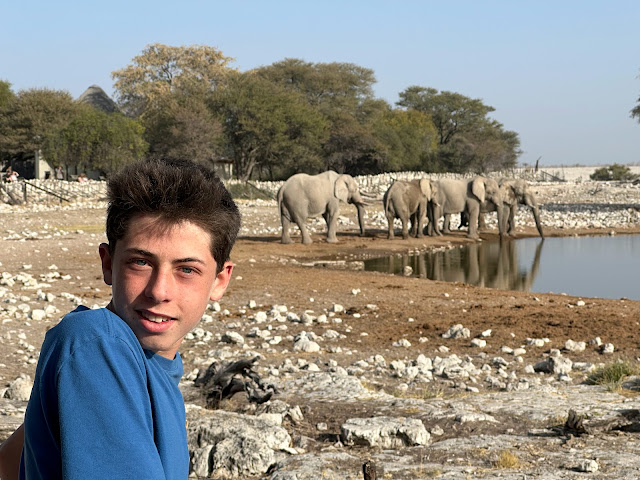










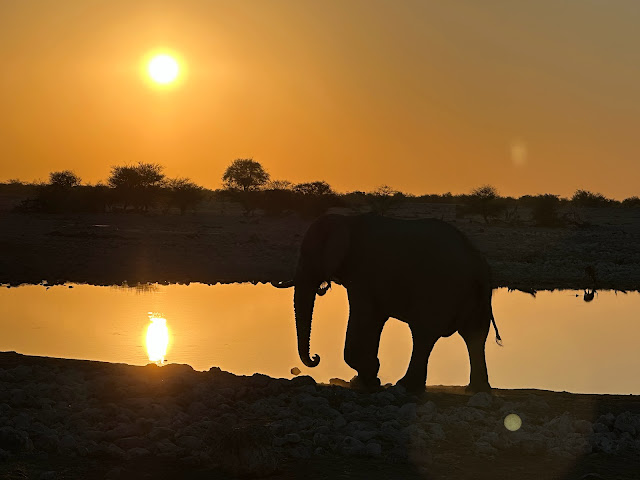




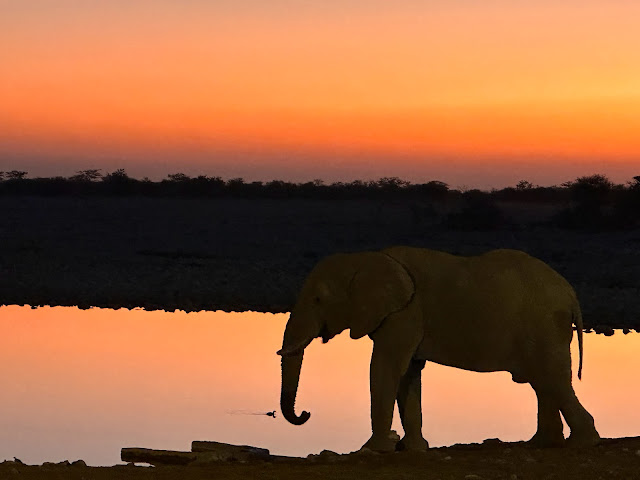



















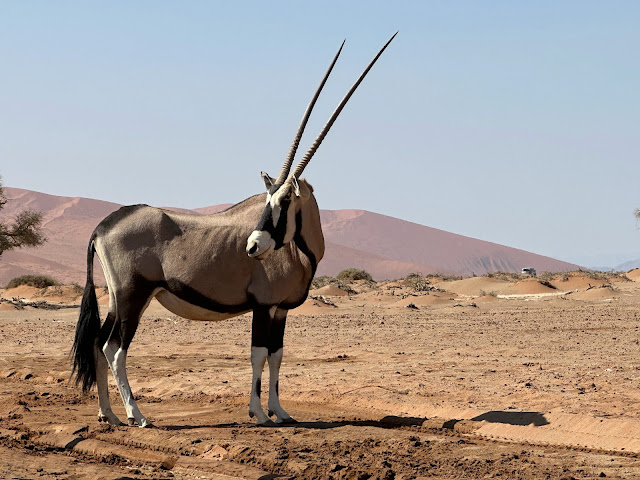






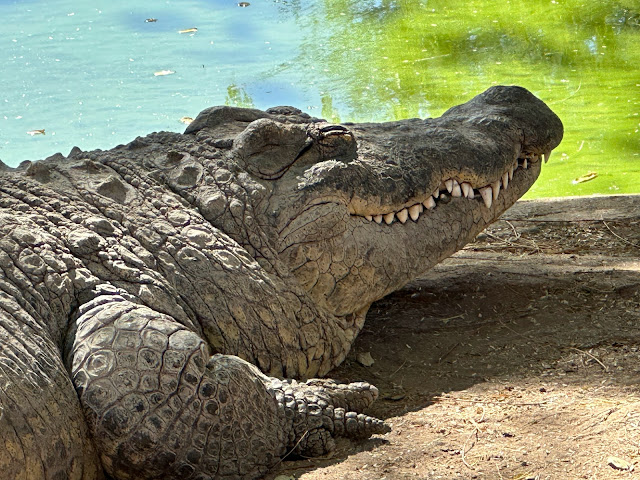




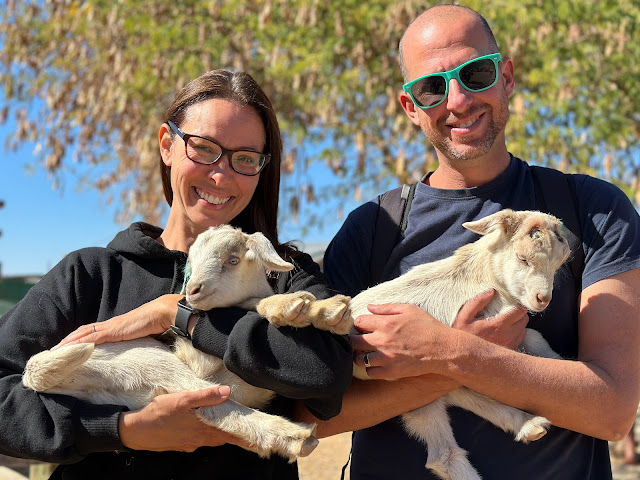







Wow Andrea! What an incredible post! Thank you for these lessons about a world I don’t know anything about. And the gorgeous photographs. Looking forward to the next post on Mauritius.
ReplyDelete